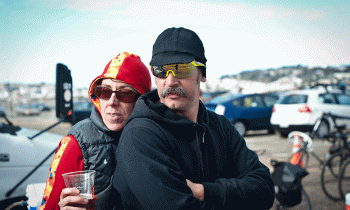Well, at least they’re one of the more spectacular sights at Santa
Cruz
Sunday, October 3, 1999
Silicon Valley Magazine
By Karen Kefauver
There is nothing like a leisurely afternoon observing wildlife to break from work and have a reminder of our humble origins. My favorite place for reflection on the variety of species thriving here on the Central Coast is at Natural Bridges State Beach in Santa Cruz. Watching creatures in their natural habitat is a reassurance that some conservation efforts have paid off though many battles remain.
The 65-acre park on the north end of West Cliff Drive is home to the snowy egret, the gray fox and the beleaguered gopher. The park’s beach offers an excellent vantage point for viewing shore birds, seals, sea otters and sea lions. If you have trouble distinguishing these marine mammals like I do, the visitor center provides helpful displays and guides.
At low tide, it’s fun to explore the tidepools and search for sea stars, anemones, crabs, sea slugs and snails. Even if I don’t find a purple sea urchin, I like to watch the kids shriek with delight at the sight of a hermit crab racing across the rocks. During February and March, I pull out my binoculars to look for the gray whales on their way to Baja from Alaska, part of their biannual 10,000-mile roundtrip migration.
At this time of year, the mighty monarch takes central stage. The park’s Monarch Butterfly Natural Preserve attracts up to 150,000 butterflies from early October through the end of the February. Located next to the visitor center, the entrance to the preserve leads to a 5-minute walk down a wooden boardwalk into the fragrant eucalyptus grove.
“The monarchs choose this area because of protection from wind and rain. It is not too warm, but they need cool weather and moist air. It’s the perfect micro-climate,” explained Julie Sidel, Interpretive Specialist at Natural Bridges. “There is a flurry of mating around February. Towards the end of the month, they fly in search of milkweed patches. The females will lay hundreds of eggs. In spring, they will turn into butterflies. They live six to nine months.”
The monarchs rest in the eucalyptus grove after their sojourn as far as 2,000 miles. Sometimes they cluster so densely that the tree branches are completely covered by their delicate black and orange wings. In the spring, they return inland to valley regions west of the Rocky Mountains.
The park also maintains a milkweed patch that shows the Danaus plexippus in earlier phases of development — monarch eggs, caterpillars and chrysalises.
In celebration of the butterfly, the park hosts its annual Welcome Back Monarch Day, from 10 a.m. to 4 p.m. on Sunday, October 10. “It’s a fun and funky festival,” said organizer Julie Sidel. In honor of this year’s 20th anniversary, the free festival includes a retrospective of the past two decades, music by the Mostly Mediocre Musical Monarch Mariposas, and appearances by “superheroes”: Monarch Man, Monarch Woman and Caterpillar Boy. At the migration parade, costumes are encouraged.
The fesitval also features the history of Natural Bridges, which was named for the arches carved out of the sandstone cliff. Two of the three brigdes have collapsed. The middle bridge remains but is succumbing to erosion. The arches were popular places for early settlers to have picnics and hold weddings. The Ohlone Indians were the first inhabitants of the area.
There is only one precaution for this excursion: watch out for poison oak and stinging nettles, which are easily avoided if you stay on the trails. Also take good walking shoes and a windbreaker for morning fog. You may want to leave the dog at home since pets are allowed in parking lots and picnic areas only and cost $1 extra at the park entrance, at the corner of West Cliff Drive and Swanton Blvd. The parking fee is $6 for the day, but you can find free parking on Delaware Ave. and Natural Bridges State Drive, by Silicon Systems, a few minutes from Highway 1.
Finally, be sure to pack a picnic since no day trip is complete without a hearty lunch! You can pick up tasty fare near Natural Bridges at Beckmann’s Bakery or New Leaf’s deli, both on Mission Street. If time permits, wander a few miles down Delaware to UCSC’s Joseph M. Long Marine Labarotory, where free tours of marine mammals and sharks are available. (Call 831-459-3854). The LML is currently in transition as they move into spacious 20,000-foot Seymour Marine Discovery Center, which will open in spring 2000.
Natural Bridges’ free Monarch Tours begin October 12 and take place every Saturday and Sunday, 11 a.m. and 2 p.m., through February. For more information, call (831) 423-4609.
KAREN KEFAUVER is a Santa Cruz-based freelance writer.





